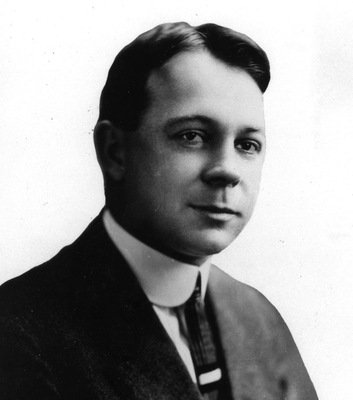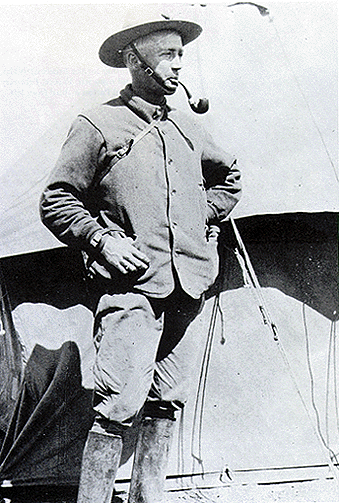Raging wildfires have so far consumed over 15,000 structures, killed 16, and are estimated to have caused damages in excess of $160 Billion. The end of this catastrophe is not in sight as the major fires are less than twenty percent contained. The extent of the devastation will not be revealed for months.
The big question that arises is what happens next. Do we have some precedent in the past that we can draw on to predict what will happen or guard against what could happen. California is the sixth largest economy in the world and one of the main drivers of innovation in the world.
In 2012, I wrote a book about the Mexican Revolution, in which I traced the outbreak of this catastrophic civil war to the California earthquake of 1906. The parallels to what is happening in California today are haunting. What happens next will likely not be good…
Soldier-of-Fortune Emil Holmdahl patrolling the streets of San Francisco to prevent looting.
The international economic climate in the early nineteen hundreds showed sunshine for the foreseeable future. Just as happens with most business cycles, unforeseen events can suddenly impact the financial summer and initiate a downturn. The profitable days of the new century received a deafening blow at precisely 5:12 a.m. on Wednesday, April 18, 1906. Within forty-two seconds an earthquake somewhere between 7.7 and 8.25 on the Richter scale destroyed the vibrant city of San Francisco and adjacent towns and villages, leaving over three thousand dead.[1] 25,000 buildings in 490 city blocks succumbed to the subsequent fires caused by burst gas lines. Historians estimate the damages caused by the earthquake to have amounted to around $400 Million (8.8 Billion in today’s value). While many insurance companies cut corners and did not pay, the hefty insurance payments of the 137 remaining insurers brought the international financial system to the brink.
“In April 1906 the San Francisco earthquake and fire caused damage equal to more than 1 percent of GNP. Although the real effect of this shock was localized, it had an international financial impact: large amounts of gold flowed into the country in autumn 1906 as foreign insurers paid claims on their San Francisco policies out of home funds. This outflow prompted the Bank of England to discriminate against American finance bills and, along with other European central banks, to raise interest rates. These policies pushed the United States into recession which started in June 1907.” [2]
As is the case in most economic downturns the retreating levels of cash and liquidity brought to light both legal and illegal financial schemes setting the stage for the Panic of 1907.
F. Augustus Heintze
The events that led to one of the greatest run on banks in history appear benign and disconnected. On October 16th 1907 the stock of United Copper Company plummeted from a high of $62 per share to $15.[3] It wiped out the fortunes of one F. Augustus Heintze, president of the Mercantile National Bank of New York. The colorful millionaire from Montana had attempted to corner the copper market. John D. Rockefeller, heavily invested in copper commodities, countered Heintze’s attempt and unloaded millions of pounds of copper into the market.[4] The price of copper as well as copper shares plummeted. Heintze was finished! The man known on Wall Street as a man whose investments always turned to gold took with him his own savings and loan, the Butte [Montana] Savings Bank and the Mercantile National Bank of New York. Investors quickly learned of the many interconnected schemes of Wall Street players and feared the worst. “Although United Copper was only a moderately important firm, the collapse of Heintze's scheme, exposed an intricate network of interlocking directorates across banks, brokerage houses, and trust companies in New York City. Contemporary observers like O.M.W. Sprague (1910) believed that the discovery of the close associations between bankers and stockbrokers seriously raised the anxiety of already nervous depositors.”[5]
On October 18, 1907, panicking depositors initiated a run on the Knickerbocker Trust Company in New York.[7] John Pierpont Morgan himself entered the fray. He organized a bail out committee including James Stillman (of National City Bank), and George F. Baker (of First National Bank), the most powerful bankers in New York. As Knickerbocker faltered, other banks faced runs on their deposits. The New York Stock Exchange had to cease trading as the bottom fell out. As a committee the three financiers decided on a case-by-case basis whether and with how much to support banks whose deposits faltered. Numerous institutions including the City of New York and the New York Stock Exchange thus survived by the skin of their teeth.[8] By October 24, J. P. Morgan and the U.S. government decided on a formidable and unprecedented $25 million bailout for New York’s financial institutions. John D. Rockefeller, maybe having second thoughts about his role in the panic, seconded the government-backed lifeline with a $10 million commitment of his own. For a while the future of the American financial system hung in the balance. J. P. Morgan asked New York’s clergy to pray for “calm and forbearance.” Whether with God’s or J. P. Morgan’s help or as a combination of both, the great bank panic of 1907 ended as quickly as it had come about. Investor confidence recovered within a month and the recession ended in June 1908, almost exactly a year after it had started. The stock market soared to ever-new heights, surpassing pre-panic levels by 1909.[9] However, the shock waves of San Francisco’s earthquake of 1906 that combined in catastrophic resonance with the implosion of F. A. Heintze’s fortunes in 1907 precipitated the Federal Reserve Act of December 1912.
Although Morgan, Stillman, Baker, Rockefeller, and the American government saved the U.S. financial system in those tense days of October 1907, Wall Street’s high-risk gambles had far reaching effects around the world. One of the countries affected most was Mexico. Diaz’ regime had successfully rid itself of the dependence on European loans. With the turn of the century American cash had provided the necessary capital for investments in railroads, mining, agriculture, and other industry. Especially the northern states of Mexico, Sonora, Chihuahua, and Coahuila, depended heavily on interstate commerce and U.S. loans. In a matter of months after the recession started in June 1907, the “U.S. depression crippled the Mexican economy.”[10] While the crisis of 1907 brought irresponsible financial schemes on Wall Street to the surface, the cash crunch laid bare structural and social deficiencies in Porfirio Diaz’ Mexico.
As Wall Street financiers worked to pull the banking system from the brink of collapse, Mexico’s economy felt the sting of a tight international credit market. Worried about inflation, the Mexican Finance Minister José Ives Limantour “restricted credit and followed deflationary policies.”[11] Between 1907 and 1909, the total revenue of Mexico declined by over fourteen percent.[12] Coinciding with a widespread drought between 1908 and 1909, prices for food and staples increased while real wages decreased. The collapse of metal prices in 1907 left American and Mexican mining operators in Northern Mexico without a viable export market. Thousands of miners lost their jobs while countless others had to stomach pay cuts.
“One of the largest U.S. mining companies doing business in Mexico, the American Smelting and Refining Company (ASARCO), shut down its mines at Santa Eulalia and Santa Barbara in Chihuahua, throwing more than 1,000 people out of work. Most mines in the largest mining center in the state, Hidalgo del Parral, also shut down. The economic empire of William C. Greene, an American tycoon who owned a large number of mines, most of them in Sonora, and had set up vast lumberyards in western Chihuahua, collapsed, greatly increasing the number of unemployed, especially in western Chihuahua.”[13]
Greene had already attracted the ire of Mexican workers in 1906 when he “browbeat the governor of Sonora into allowing American irregulars across the border” to break the strike at the Cananea mines.[14] The latest lay-offs and closings of unprofitable pieces in Greene’s network of businesses added to the outrage lower and middle class Mexicans felt towards foreign investment in their country. Since the Mexican economy, especially along the northern border, was so tightly linked to that of the United States, there were no jobs for the unemployed miners and impoverished farmers. Widespread discontent with the political leadership of Mexico, which seemed to be out of touch with the economic disaster, increased the clamor for economic and political reform. In Chihuahua the Creel-Terrazas clan who controlled ranches the size of Belgium showed little inclination to ease the suffering.[15] In 1908 the boundless greed of the state’s ruling oligarchy reached new heights when robbers stole $300,000 Pesos from the Banco Minero of Chihuahua City, Governor Creel’s own bank. After the Chihuahua authorities arrested five suspects, imprisoned and tortured them for the better part of a year, it became clear that it was Creel’s own family who had committed the heist.[16] The dire economic situation of workers, farmers, shop owners, and businessmen, the unresolved succession crisis of the aging ruling elite, and the brutal suppression of opposition newspapers and agitators, fomented an explosive mix of discontent among virtually all levels of Mexican society. In this environment three brothers from Germany entered the fray and navigated their late father’s business in Parral, Chihuahua in 1908.
The excerpt is from my book In Plain Sight: Felix A. Sommerfeld, Spymaster in Mexico, 1908 to 1914 (Amissville: Henselstone Verlag, 2012).
[1] There are on-going discussions with respect to magnitude since the Richter scale did not exist in 1906. Richter himself calculated 8.3 in 1958, which is disputed today. For more information see http://earthquake.usgs.gov/regional/nca/1906/18april/magnitude.php, viewed 05-2010.
[2] Abstract from Kerry A. Odell and Marc D. Weidenmier, “Real Shock, Monetary Aftershock: The 1906 San Francisco Earthquake and the Panic of 1907,” The Journal of Economic History, vol. 64, issue 4 (2005), 1002–1027.
[3] Federal Reserve Bank of Boston, “The Panic of 1907,” Boston, MA, 2002. For more detail see also Jon Moen, "Panic of 1907," EH.Net Encyclopedia, edited by Robert Whaples. August 14, 2001.
[4] Kevin J. Cahill, “The U.S. Bank Panic of 1907 and the Mexican Depression of 1908-1909,” The Historian, Vol. 60, Issue 4 (1998), 795 to 811.
[5] Moen, "Panic of 1907."
[6] NA RG 165 Department of War, Holmdahl Papers, public domain.
[7] There is a dispute about when the run on the bank started. See Vincent P. Carosso, Rose C. Carosso, The Morgans: Private International Bankers, 1854-1913 (Cambridge: Harvard Studies in Business History, Harvard University Press, 1987). Drawing from information of the private papers of J.P. Morgan, Carosso concluded that the panic started on October 18 not 21 as other historians had claimed.
[8] Carosso, The Morgans, 535-549.
[9] Robert F. Bruner, Sean D. Carr, The Panic of 1907: Lessons Learned from the Market’s Perfect Storm (Hoboken: John Wiley and Sons, 2007), 143.
[10] Cahill, “The U.S. Bank Panic of 1907,” 795 to 811.
[11] Frank McLynn, Villa and Zapata: A History of the Mexican Revolution, (New York: Basic Books, 2000), 22.
[12] Lill, National Debt of Mexico, 1919, 80.
[13] Friedrich Katz, The Life and Times of Pancho Villa, (Stanford: Stanford University Press, 1998.Katz), 48-49.
[14] McLynn, Villa and Zapata, 2000, 21.
[15] Katz, Life and Times of Pancho Villa, 1998, 50.
[16] Ibid., 50-52.




































